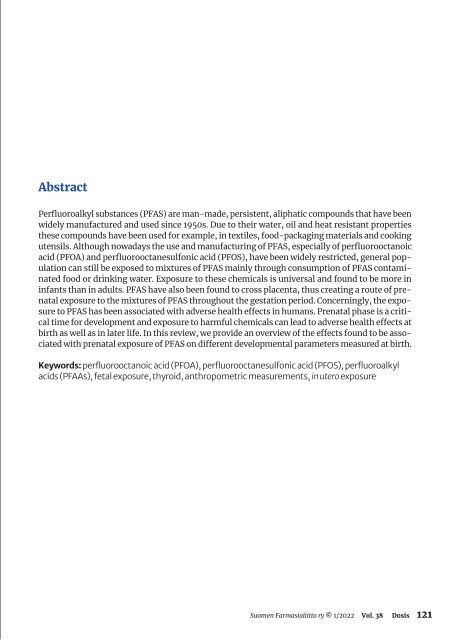DOSIS 1/2022
Farmaseuttinen aikakauskirja DOSIS 4/2021 vol.37 5uomen Farmasialiitto ry
Farmaseuttinen aikakauskirja DOSIS 4/2021 vol.37 5uomen Farmasialiitto ry
Create successful ePaper yourself
Turn your PDF publications into a flip-book with our unique Google optimized e-Paper software.
Abstract<br />
Perfluoroalkyl substances (PFAS) are man-made, persistent, aliphatic compounds that have been<br />
widely manufactured and used since 1950s. Due to their water, oil and heat resistant properties<br />
these compounds have been used for example, in textiles, food-packaging materials and cooking<br />
utensils. Although nowadays the use and manufacturing of PFAS, especially of perfluorooctanoic<br />
acid (PFOA) and perfluorooctanesulfonic acid (PFOS), have been widely restricted, general population<br />
can still be exposed to mixtures of PFAS mainly through consumption of PFAS contaminated<br />
food or drinking water. Exposure to these chemicals is universal and found to be more in<br />
infants than in adults. PFAS have also been found to cross placenta, thus creating a route of prenatal<br />
exposure to the mixtures of PFAS throughout the gestation period. Concerningly, the exposure<br />
to PFAS has been associated with adverse health effects in humans. Prenatal phase is a critical<br />
time for development and exposure to harmful chemicals can lead to adverse health effects at<br />
birth as well as in later life. In this review, we provide an overview of the effects found to be associated<br />
with prenatal exposure of PFAS on different developmental parameters measured at birth.<br />
Keywords: perfluorooctanoic acid (PFOA), perfluorooctanesulfonic acid (PFOS), perfluoroalkyl<br />
acids (PFAAs), fetal exposure, thyroid, anthropometric measurements, in utero exposure<br />
Suomen Farmasialiitto ry © 1/<strong>2022</strong> Vol. 38 Dosis 121

















